-
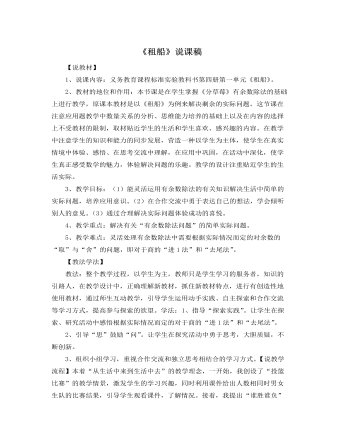
北师大版小学数学二年级下册《租船》说课稿
3、教学目标:(1)能灵活运用有余数除法的有关知识解决生活中简单的实际问题,培养应用意识。(2)在合作交流中勇于表达自己的想法,学会倾听别人的意见。(3)通过合理解决实际问题体验成功的喜悦。4、教学重点:解决有关“有余数除法问题”的简单实际问题。5、教学难点:灵活处理有余数除法中需要根据实际情况而定的对余数的“取”与“舍”的问题,即对于商的“进1法”和“去尾法”。【教法学法】教法:整个教学过程,以学生为主,教师只是学生学习的服务者,知识的引路人,在教学设计中,正确理解新教材,抓住新教材特点,进行有创造性地使用教材,通过师生互动教学,引导学生运用动手实践、自主探索和合作交流等学习方式,提高参与探索的欲望。学法:1、指导“探索实践”。让学生在探索、研究活动中感悟根据实际情况而定的对于商的“进1法”和“去尾法”。2、引导“思”鼓励“问”。让学生在探究活动中勇于思考,大胆质疑,不断创新。
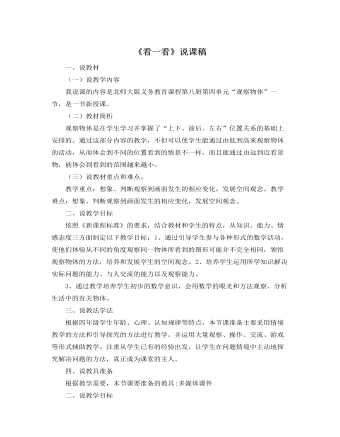
北师大版小学数学四年级下册《看一看》说课稿
一、说教材(一)说教学内容我说课的内容是北师大版义务教育课程第八册第四单元“观察物体”一节,是一节新授课。(二)教材简析观察物体是在学生学习并掌握了“上下、前后、左右”位置关系的基础上安排的。通过这部分内容的教学,不但可以使学生能通过由低到高来观察物体的活动,从而体会到不同的位置看到的情景不一样,而且能通过由远到近看景物,能体会到看到的范围越来越小。(三)说教材重点和难点。教学重点:想象、判断观察到画面发生的相应变化,发展空间观念。教学难点:想象、判断观察到画面发生的相应变化,发展空间观念。二、说教学目标依照《新课程标准》的要求,结合教材和学生的特点,从知识、能力、情感态度三方面制定以下教学目标:1、通过引导学生参与各种形式的数学活动,使他们体验从不同的角度观察同一物体所看到的图形可能并不完全相同,领悟观察物体的方法,培养和发展学生的空间观念。2、培养学生运用所学知识解决实际问题的能力、与人交流的能力以及观察能力。
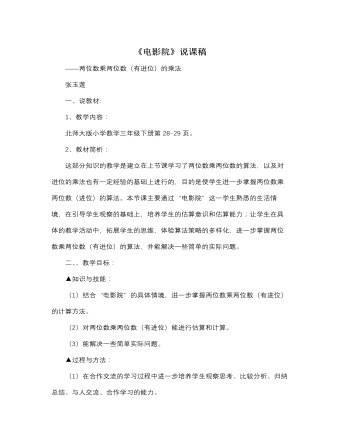
北师大版小学数学三年级下册《电影院》说课稿
一、说教材:1、教学内容:北师大版小学数学三年级下册第28-29页。2、教材简析:这部分知识的教学是建立在上节课学习了两位数乘两位数的算法,以及对进位的乘法也有一定经验的基础上进行的,目的是使学生进一步掌握两位数乘两位数(进位)的算法。本节课主要通过“电影院”这一学生熟悉的生活情境,在引导学生观察的基础上,培养学生的估算意识和估算能力;让学生在具体的教学活动中,拓展学生的思维,体验算法策略的多样化,进一步掌握两位数乘两位数(有进位)的算法,并能解决一些简单的实际问题。二、、教学目标:▲知识与技能:(1)结合“电影院”的具体情境,进一步掌握两位数乘两位数(有进位)的计算方法。(2)对两位数乘两位数(有进位)能进行估算和计算。(3)能解决一些简单实际问题。
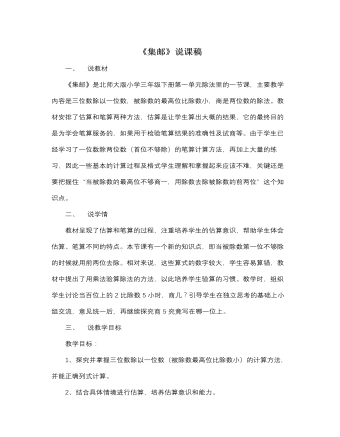
北师大版小学数学三年级下册《集邮》说课稿
《集邮》是北师大版小学三年级下册第一单元除法里的一节课,主要教学内容是三位数除以一位数,被除数的最高位比除数小,商是两位数的除法。教材安排了估算和笔算两种方法,估算是让学生算出大概的结果,它的最终目的是为学会笔算服务的,如果用于检验笔算结果的准确性及试商等。由于学生已经学习了一位数除两位数(首位不够除)的笔算计算方法,再加上大量的练习,因此一些基本的计算过程及格式学生理解和掌握起来应该不难,关键还是要把握住“当被除数的最高位不够商一,用除数去除被除数的前两位”这个知识点。二、说学情教材呈现了估算和笔算的过程,注重培养学生的估算意识,帮助学生体会估算、笔算不同的特点。本节课有一个新的知识点,即当被除数第一位不够除的时候就用前两位去除。相对来说,这些算式的数字较大,学生容易算错,教材中提出了用乘法验算除法的方法,以此培养学生验算的习惯。
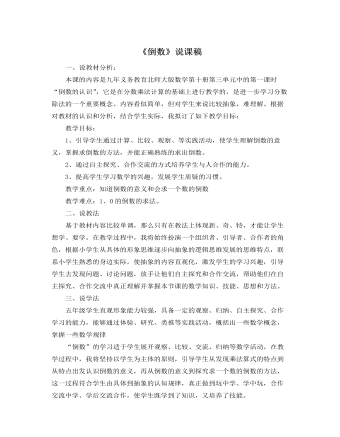
北师大版小学数学五年级下册《倒数》说课稿
教学目标:1、引导学生通过计算、比较、观察、等实践活动,使学生理解倒数的意义,掌握求倒数的方法,并能正确熟练的求出倒数。2、通过自主探究、合作交流的方式培养学生与人合作的能力。3、提高学生学习数学的兴趣,发展学生质疑的习惯。教学重点:知道倒数的意义和会求一个数的倒数教学难点:1、0的倒数的求法。二、说教法基于教材内容比较单调,那么只有在教法上体现新、奇、特,才能让学生想学、要学。在教学过程中,我将始终扮演一个组织者、引导者、合作者的角色,根据小学生从具体的形象思维逐步向抽象的逻辑思维发展的思维特点,联系小学生熟悉的身边实际,使抽象的内容直观化,激发学生的学习兴趣,引导学生去发现问题、讨论问题,放手让他们自主探究和合作交流,帮助他们在自主探究、合作交流中真正理解并掌握本节课的数学知识、技能、思想和方法。
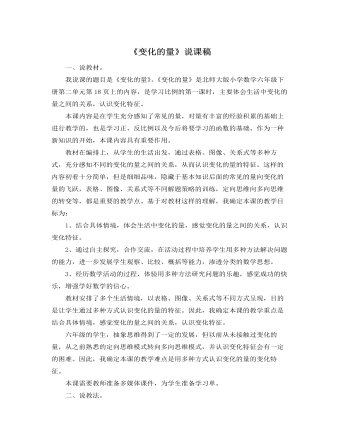
北师大版小学数学六年级下册《变化的量》说课稿
1、结合具体情境,体会生活中变化的量,感觉变化的量之间的关系,认识变化特征。2、通过自主探究,合作交流,在活动过程中培养学生用多种方法解决问题的能力,进一步发展学生观察、比较、概括等能力,渗透分类的数学思想。3、经历数学活动的过程,体验用多种方法研究问题的乐趣,感觉成功的快乐,增强学好数学的信心。教材安排了多个生活情境,以表格、图像、关系式等不同方式呈现,目的是让学生通过多种方式认识变化的量的特征。因此,我确定本课的教学重点是结合具体情境,感觉变化的量之间的关系,认识变化特征。六年级的学生,抽象思维得到了一定的发展,但以前从未接触过变化的量,从之前熟悉的定向思维模式转向多向思维模式,并认识变化特征会有一定的困难。因此,我确定本课的教学难点是用多种方式认识变化的量的变化特征。本课需要教师准备多媒体课件,为学生准备学习单。
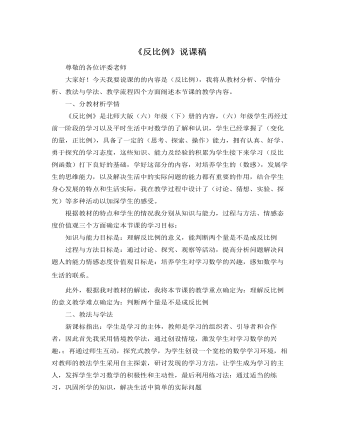
北师大版小学数学六年级下册《反比例》说课稿
知识与能力目标是:理解反比例的意义,能判断两个量是不是成反比例过程与方法目标是:通过讨论、探究、观察等活动,提高分析问题解决问题人的能力情感态度价值观目标是:培养学生对学习数学的兴趣,感知数学与生活的联系。此外,根据我对教材的解读,我将本节课的教学重点确定为:理解反比例的意义教学难点确定为:判断两个量是不是成反比例二、教法与学法新课标指出:学生是学习的主体,教师是学习的组织者、引导者和合作者,因此首先我采用情境教学法,通过创设情境,激发学生对学习数学的兴趣,;再通过师生互动,探究式教学,为学生创设一个宽松的数学学习环境,相对教师的教法学生采用自主探索,研讨发现的学习方法,让学生成为学习的主人,发挥学生学习数学的积极性和主动性,最后利用练习法:通过适当的练习,巩固所学的知识,解决生活中简单的实际问题
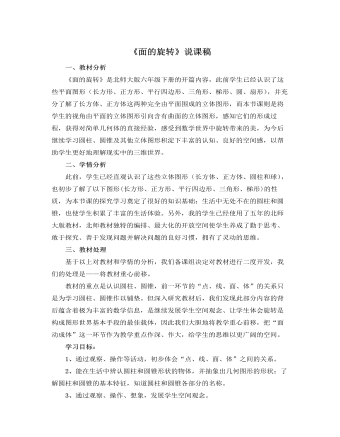
北师大版小学数学六年级下册《面的旋转》说课稿
2.放大空间,升华思考由于我对教材的二度开发留给了学生足够的探索空间,课上学生探索数学的热情被充分调动,我们欣喜地看到:有的学生尝试着不同平面图形的旋转;有的学生只用一种平面图形,却旋转出不同的立体图形;有的学生的思维并没有停留在表象上,而是在深入地思考产生这一现象的原因……交流时学生的发现远远超出了我们的想象,这份生成带给我们的是惊喜,是赞叹,更是“以操作促思考”的教学行为结出的硕果。3.巧用课件,形成表象本节课,我充分运用现代信息技术将平面图形经过旋转形成立体图形的过程生动、逼真地再现出来,帮助学生将抽象的空间想象化为直观,进而形成表象,深植于学生的脑海中,促进了学生空间观念的形成。总之,在这节课上,我坚持把“促进学生发展”作为第一要素贯穿于课堂教学的始终,让学生在充满着民主、探究、思考的氛围中,积极操作、主动思考,发展了学生的空间观念。
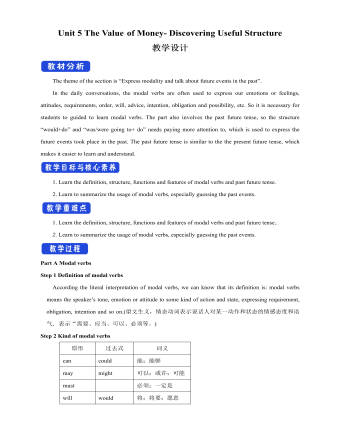
新人教版高中英语必修3Unit 5 The Value of Money- Discovering Useful Structure教学设计
Step 3 Meaning1. 过去将来时表示从过去某一时间来看将要发生的动作或存在的状态, 常用在宾语从句中。一般由“would/should +动词原形”构成。She hoped that they would meet again someday. 她希望将来有一天他们能再见面。2. was/were going to+动词原形: 表示过去将要发生或很有可能发生的动作, 常用于口语中, 表示预言、意图或者打算等。He was going to start work the following week. 他打算下星期开始工作。3. was/were about to do: 常用来表示即将发生的动作, “刚要/正要做……”。注意该结构不与任何时间状语连用。I felt that something terrible was about to happen. 我感到某种可怕的事情即将发生。4.was/were to do: 表示“曾计划做某事”, 如果表示“本来计划做某事, 动作没实现”, 则需用 “was/were to have done”。She said she was to have told me about the accident. 她说她本来想告诉我关于事故的事。5.Start, go, come, leave, see, meet等动词的过去进行时: 表示就过去某一时刻而言即将发生的动作。She was coming later. 她随后就来。I had just put on my overcoat and was leaving to visit a friend of mine. 我刚穿上外套要去看我的一个朋友。
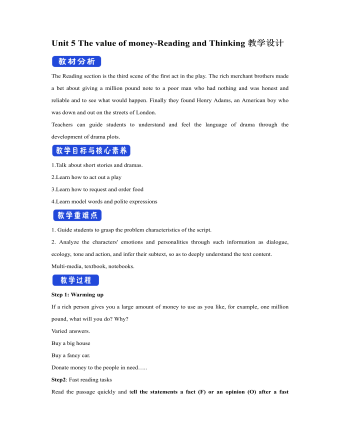
新人教版高中英语必修3Unit 5 The value of money-Reading and Thinking教学设计二
? Could you offer me some kind of work here?? I don’t want your charity, I just want an honest job.? Careless: I landed in Britain by accident.Step 7:Consolidation.? Find Henry? Roderick and Oliver were I .making a bet when they saw Henry, a poor young man. ? Know Henry? About a month ago, Henry was sailing and later he found himself carried out to sea by a strong wind. Fortunately, he 2.was spotted by a ship. And it was the ship that brought him to 3.England? Offer money to Henry ? Oliver and Roderick gave Henry a letter and told him that there was money in it. They 4.persuaded him to accept it, and made him 5.promise that it wouldn't be opened until 2 o'clock.Step 8:Language pointsa large amount of: a large quantity of; a great deal ofe.g. They bought a large amount of furniture before they moved their new house.make a bet: make an arrangement to risk money, etc. on an event of which the result is doubtful.e.g. We made a bet on the result of the match.permit sb to do something: allow somebody to do somethinge.g. My mother doesn’t permit me to ride in the street after it rained.by accident: as a result of chancee.g. I only found it by accident.stare at: look at somebody or something with the eyes wide open in a fixed gaze( in astonishment, wonder, fear, etc)to be honest: to tell you the truth; to be franke.g. To be honest, I don’t think we have a chance of winning.Step7 Homework:What do you think will happen to Henry? Will the bank-note help him or get him into trouble?
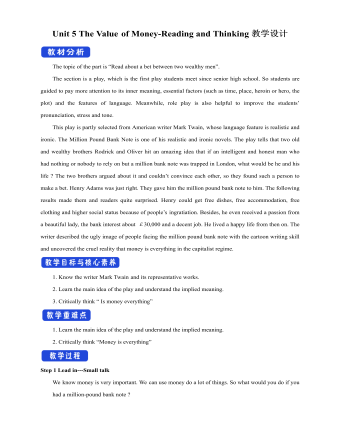
新人教版高中英语必修3Unit 5 The Value of Money-Reading and Thinking教学设计一
Everybody wants to get wealth.In today’s material world,making money or becoming wealthy symbolizes a person’s success and capability. Many people just make every effort, pay any price to attain greater wealth. With money,they can buy nice, large apartments in nice neighborhood. With money they can own luxurious cars. Wealth seems to bring all happiness in life.But is wealth the only road to happiness? Not really. There are many things in the world, which are beyond the means of money, such as friendship, love, health and knowledge. People are so preoccupied with struggling for money that they have no time or would not take the time to form or maintain friendship. What happiness can they feel living as lonely miserable creatures without love or friends in the world even if they accumulate tremendous wealth?In my opinion, people can’t do anything without money, but money is not everything. What money will bring you depends on your personal belief and goal in life. If you are kind enough to help others, especially the poor, money is a good thing to you. With it, you can do much more for the benefit of people and your country, and it will add to your own happiness. If you want money just for your own needs, you’ll never be satisfied or happy. In a word,you should have money spent for more people. Only then can money be the source of your happiness.Step 8 Homework4 students in a group, one acts Roderick, one Oliver, one servant and the fourth one acts Henry Adams, then listen to the tape, pay more attention to the difference between American English and British English in pronunciation, stress, tone.
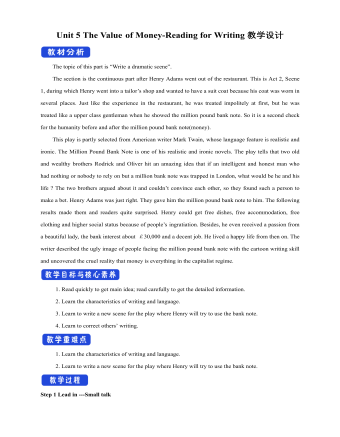
新人教版高中英语必修3Unit 5 The Value of Money-Reading for Writing教学设计二
2. 您能看到, 我头发太长了。You can see that my hair is much too long.3. 无论什么时候, 只要您想回来就回来。Please come back whenever you want.4. 您仅有很少的头发要理! You only have too little hair to cut !5. 为您服务是我的荣幸!It is my honour to serve you!Step 9 Writing(Henry is walking down the street when he sees a sign for a place that cuts hair. He decides to have it cut. )H=Henry B=BarberH: Good afternoon, I’d like to have my hair cut, if I may. (The barber looks at Henry’s hair and continues cutting another man’s hair. ) Er, I’d really like a haircut. As you can see it’s much too long. B: (in a rude manner) Yes, I can see that. Indeed, I can. H: Fine, well, I’ll have a seat then. (He sits in one of the barber’s chairs. The barber turns to look at Henry. )B: It’s quite expensive here, you know! Are you sure you can afford it?H: Yes. I think so. (After his hair is cut, the barber tells Henry how much he must pay. Henry shows the barber the bank note. )B: Why Mr. . . (looks shocked)H: Adams. Henry Adams. I’m sorry. I don’t have any change. B: Please don’t worry! (wearing a big smile) Nothing to worry about! Nothing at all! Please come back whenever you want, even if you only have too little hair to cut! It will be my honour to serve you!Step 10 Pair workExchange drafts with a partner. Use this checklist to help your partner revise his/her draft.1. Are all the elements of a play included and in good order ?2. Do the character use suitable language ?3. Are the stage directions clear and useful ?4. Is the plot clear and exciting enough ?
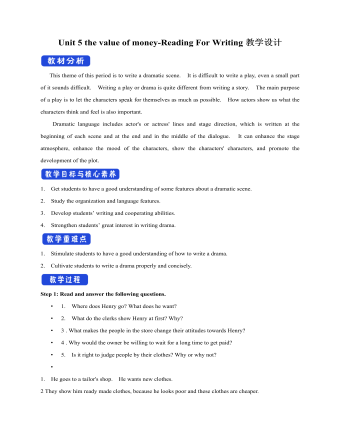
新人教版高中英语必修3Unit 5 the value of money-Reading For Writing教学设计一
【参考范文】Narrator:(Henry is smiling as he leaves the restaurant. As he is walking down the street, he sees a sign for a place that cuts hair. He decides to get it cut. )H=Henry;B=Barber;R=rude manH:Good afternoon, I'd like to get a cut, if I may. (The barber looks at Henry's hair and continues cutting another man's hair. )Er, I'd really like a haircut. As you can see it's much too long. B:(in a rude manner) Yes, I can see that. Indeed, I can. H:Fine, well I'll have a seat then. (He sits in one of the barber's chairs. The barber turns to look at Henry. )B:It's quite expensive here, you know!Are you sure you can afford it?H:Yes. I think so. (In comes the rude man. )R:Hey you there. I need a haircut quickly. Can you do me straightaway?B:All right, then, get in the chair and I'll see what I can do. R:Thank you. (sits down in one of the barber's chairs)H:Excuse me, but I was here first. Aren't you going to do my hair first?B:This man's in a hurry. H:Well so am I!I insist that you cut my hair first. B:OK, but I'll have to be quick. This gentleman is waiting. H:Thank you. (They both become quiet. After his hair is cut, the barber tells Henry how much he must pay. Henry shows the barber the bank note. )B:Why, Mr . . . (looks shocked)H:Adams. Henry Adams. I'm sorry, I don't have any change. R:You're that Mr Adams! Well,I'm glad I waited or I might never have known it was you. B:Why, Mr Adams, please don't worry!(wearing a big smile) Nothing to worry about!Nothing at all!Please come back any time, even if you only need too little hairs cut!It will be my honour to serve you!
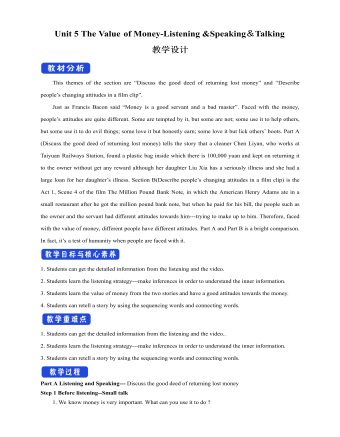
新人教版高中英语必修3Unit 5 The Value of Money-Listening &Speaking&Talking教学设计
4. A:We’d like to have someone to say a word at the beginning to welcome the group.B:↙Who?A:We thought that you or Dr.Johnson might do it.B用降调说Who,其意思是问,对方想让谁在开场时致欢迎词。Step 6 Pronunciation---Practice1. Listen to the short conversation and mark the intonation with ↗, ↙ or ↙, ↗. Then discuss with a partner what they intend to convey by using different intonation.Owner: You know what ?↗ It’s a million-pound bank note↙.Waiter 1: Really ?↗(question)Waiter 2: Really !↙(unbelievable and surprised)Waiter 3: Really ?!↙↗(first question then surprised)2. Listen to the conversations. Underline the parts that are stressed and mark the intonation. Then talk about the implied meanings of the responses with different intonations. Listen again and repeat.1) Henry: It’s a nice suit.Owner: Oh, it’s perfect!↙(The intonation means it is very suitable for Henry.)2) Henry: Well, that’s very kind of you.Owner: Kind, sir ?↗(what you said is not right) No, it’s kind of you. You must come whenever you want and have whatever you like. Just having you sit here is a great honour !!↙(welcome you to come again)3)Henry:Well, to be honest, I have none. Oliver:(happily) What luck!(excited) Brother↗, what luck!↙(It means “Didn’t you hear it?”)Henry: Well, it may seem lucky to you but not to me!↗(angry) If this is your idea of some kind of joke, I don’t think it’s very funny. Now if you’ll excuse me, I ought to be on my way.↙(If so, I would leave.)Roderick: Please don’t go↙...(hope Henry can wait for a moment)Part B Viewing and Talking---Describe people’s changing attitudes in a film clipStep 1 Before-listening---Tell the filmYou are going to watch part of the film The Million Pound Bank Note. Look at these photos and guess what happens in the film.
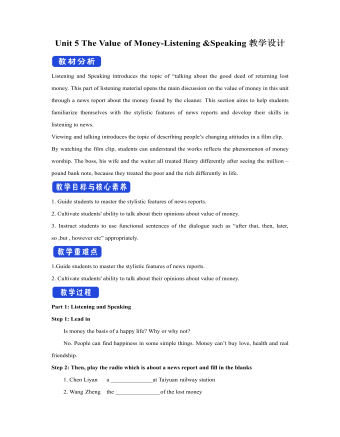
新人教版高中英语必修3Unit 5 The Value of Money-Listening &Speaking教学设计
Step 4: Listen again and decide if the following statements are true (T) or false (F).1 It was the first time Chen Liyan's story was reported. T口 F口2 Chen found 10,000 yuan in a small plastic bag in Taiyuan railway station口 F口3 Wang Zheng apologized to Chen because he couldn't offer her more money. T口 F口4 Chen took out a large loan to cure her daughter, T口 F口5 Wang set up a fundraising website for Chen's daughter after Chen told him about her situation. T口 F口Step 5:After listening, discuss the questions.1 What kind of person do you think Chen Liyan is?Chen Liyan is generous and honest because she returned a large sum of money to the owner.2 Did Chen return the money because she didn't need it?No. She returned the money because it was the right thing to do. Evidence for this is that she refused to accept the reward money because she felt that it had not been earned. 3 Is it common for people to do what Chen did?It depends on the culture. In some countries it is quite common to return money that has been found. In other countries, people believe "Finders are keepers!" 4 How did Wang Zheng feel about the return of his money?He must have been very happy and relieved to have gotten his money back. We know this because he thanked Chen repeatedly and even offered her a reward.5 Why did Ma Dongbao tell Wang about Chen's family?He must have had great sympathy for Chen and her daughter and wanted to help them.'We know this because he arranged help for them. 6 How did the news reporter feel about Chen's actions?The news reporter felt that it showed that money wasn't the most important thing in life. We know this because the reporter told us that this is what Chen believes. and then said, “that's a great attitude to take."
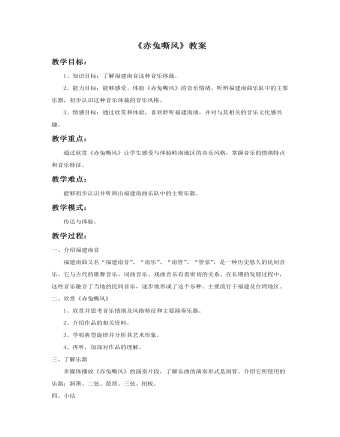
《赤兔嘶风》教案
一、介绍福建南音福建南曲又名“福建南音”、“南乐”、“南管”、“管弦”,是一种历史悠久的民间音乐。它与古代的歌舞音乐、词曲音乐、戏曲音乐有着密切的关系。在长期的发展过程中,这些音乐融合了当地的民间音乐,逐步地形成了这个乐种。主要流行于福建及台湾地区。二、欣赏《赤兔嘶风》1、欣赏并思考音乐情绪及风格特征和主要演奏乐器。2、介绍作品的相关资料。3、学唱典型旋律并分析其艺术形象。4、再听,加深对作品的理解。三、了解乐器多媒体播放《赤兔嘶风》的演奏片段,了解乐曲的演奏形式是洞管。介绍它所使用的乐器:洞箫、二弦、琵琶、三弦、拍板。
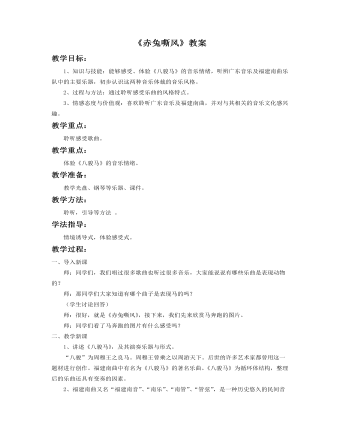
《赤兔嘶风》教案
一、导入新课师:同学们,我们唱过很多歌曲也听过很多音乐,大家能说说有哪些乐曲是表现动物的?师:那同学们大家知道有哪个曲子是表现马的吗?(学生讨论回答)师:很好,就是《赤兔嘶风》,接下来,我们先来欣赏马奔跑的图片。师:同学们看了马奔跑的图片有什么感受吗?二、教学新课1、讲述《八骏马》,及其演奏乐器与形式。 “八骏”为周穆王之良马。周穆王曾乘之以周游天下。后世的许多艺术家都曾用这一题材进行创作。福建南曲中有名为《八骏马》的著名乐曲。《八骏马》为循环体结构,整理后的乐曲还具有变奏的因素。2、福建南曲又名“福建南音”、“南乐”、“南管”、“管弦”,是一种历史悠久的民间音乐。它与古代的歌舞音乐、词曲音乐、戏曲音乐有着密切的关系。在长期的发展过程中,这些音乐融合了当地的民间音乐,逐步地形成了这个乐种。南曲包括了“指”、“谱”、“曲”三大部分。“指”是一种套曲;“谱”是有标题的器乐套曲;“曲”是有唱词的散曲,只唱不说。南曲的演奏形式有“上四管”、“下四管”之分。上四管以洞箫为主,叫做“洞管”;以笛子为主的叫做“品管”。
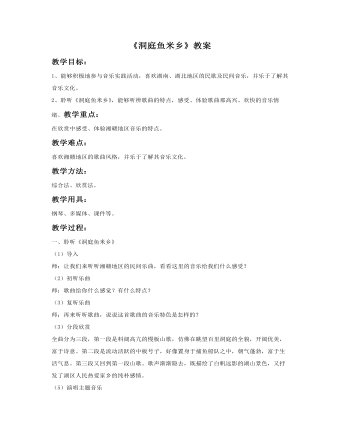
《洞庭鱼米乡》教案
一、聆听《洞庭鱼米乡》 (1)导入 师:让我们来听听湘赣地区的民间乐曲,看看这里的音乐给我们什么感受? (2)初听乐曲 师:歌曲给你什么感觉?有什么特点? (3)复听乐曲 师:再来听听歌曲,说说这首歌曲的音乐特色是怎样的?(3)分段欣赏全曲分为三段,第一段是料阔高亢的慢板山歌,仿佛在眺望百里洞庭的全貌,开阔优美,富于诗意。第二段是流动活跃的中板号子,好像置身于捕鱼船队之中,朝气蓬勃,富于生活气息。第三段又回到第一段山歌。歌声渐渐隐去,既描绘了白帆远影的湖山景色,又抒发了湖区人民热爱家乡的纯朴感情。(5)演唱主题音乐
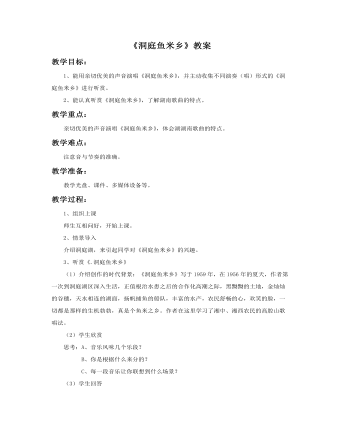
《洞庭鱼米乡》教案
教学过程:1、组织上课师生互相问好,开始上课。2、情景导入介绍洞庭湖,来引起同学对《洞庭鱼米乡》的兴趣。3、听赏《.洞庭鱼米乡》(1)介绍创作的时代背景:《洞庭鱼米乡》写于1959年,在1956年的夏天,作者第一次到洞庭湖区深入生活,正值根治水患之后的合作化高潮之际,黑黝黝的土地,金灿灿的谷穗,天水相连的湖面,扬帆捕鱼的船队,丰富的水产,农民舒畅的心,欢笑的脸,一切都是那样的生机勃勃,真是个鱼米之乡。作者在这里学习了湘中、湘西农民的高腔山歌唱法。(2)学生欣赏思考:A、音乐风味几个乐段?B、你是根据什么来分的?C、每一段音乐让你联想到什么场景?(3)学生回答
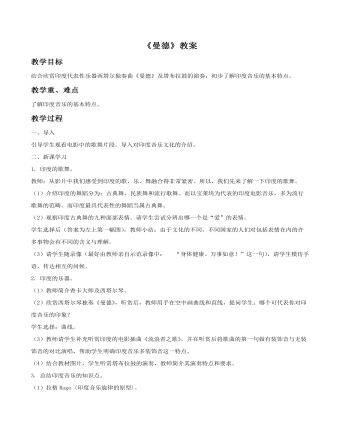
《曼德》教案
一、导入引导学生观看电影中的歌舞片段。导入对印度音乐文化的介绍。二、新课学习1. 印度的歌舞。教师:从影片中我们感受到印度的歌、乐、舞融合得非常紧密。所以,我们先来了解一下印度的歌舞。(1)介绍印度的舞蹈分为:古典舞、民族舞和流行歌舞。而以宝莱坞为代表的印度电影音乐,多为流行歌舞的范畴。而印度最具代表性的舞蹈当属古典舞。(2)观察印度古典舞的九种面部表情。请学生尝试分辨出哪一个是“爱”的表情。学生选择后(答案为左上第一幅图),教师小结:由于文化的不同,不同国家的人们对包括表情在内的许多事物会有不同的含义与理解。(3)请学生随录像(最好由教师亲自示范录像中: “身体健康、万事如意!”这一句),请学生模仿手语,传达相互的问候。

